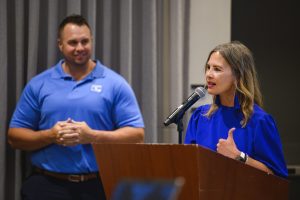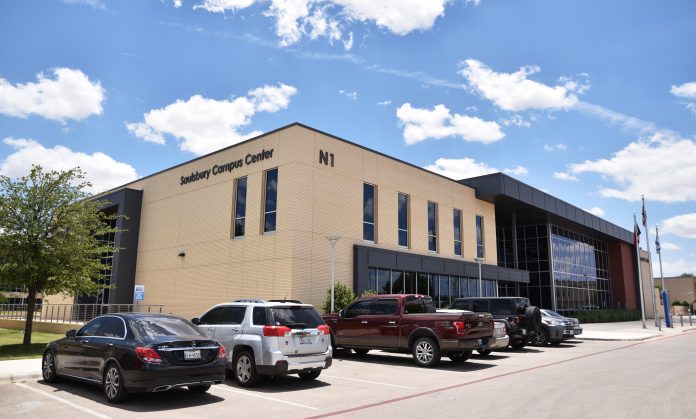With the continuing evolution of community colleges, Odessa College has become part of a network focusing on postgraduate outcomes.
Unlocking Opportunity is a network of 10 two-year colleges from across the nation that have partnered with Aspen Institute and the Community College Research Center to focus on this issue.
Initially, community colleges were a way for students to get the training they needed to find employment. About 10 to 15 years ago, they switched to access and completion because so many students who were coming in weren’t necessarily completing their studies, Vice President for Student Services Kim McKay said.
“And the completion is essential to finding gainful employment. Now we’ve moved into Unlocking Opportunity, which is Community College 3.0 that focuses on postgraduate success. You can’t look at postgraduate success after graduation. You really need to shift your thinking, to start thinking about postgraduate success during student onboarding. And so conversations about career and extended education or transfer or workforce training has to be a part of those onboarding conversations so students know how to get to the destination, how to get to a career that provides them with a family sustaining wage, and then what we expect of them and what we will provide for them along that journey,” McKay said.
McKay said the 10 colleges participating in Unlocking Opportunity are redefining what advising and high-value programs look like on their campuses, and determining if there are any “what we would consider low-value programs on our campus that don’t lead to gainful employment … or a family sustaining wage” how they transition students away from those low-value programs to high-value or high impact opportunities.
“On our campus, and on many campuses throughout the nation, one of those low-value programs is general studies because it doesn’t have real value in a career. There are valuable things, but there’s not real value in a career and sometimes not value and transfer because proceeding institutions can pick apart a general studies degree and say if you’re really wanting to be a biology major, you took way too many social sciences courses,” McKay said.
“We will, as a group of Unlocking Opportunity member colleges, rethink those conversations with students; rethink how we can assess their interests and their skills to put them on a high-value or high-impact pathway,” she added.
Each college’s version of Unlocking Opportunity is going to be a little bit different.
“Ours will focus a lot on that general studies population and connecting them with meaningful degrees that have real value in the workforce, or real value in transfer. We’re also going to take a look at the 500-plus students that aren’t selected for our selective health sciences programs every year,” McKay said.
Although there are many well qualified candidates for the health sciences programs, capacity is an issue as is not having enough clinical sites in this area. The new simulation hospital that will be part of the new Wood Health Sciences Building will help because it will give students more clinical opportunities.
McKay said OC has a responsibility to put students who aren’t admitted to the health sciences programs on a high-value pathway aligned with their career goals and also show there’s so much more to health care than just health science programs.

There are also opportunities to transition to baccalaureate programs like the bachelor of science in nursing program instead of a registered nurse program. McKay said they want to make sure students understand that there are options beyond the high-stakes selection process and that they still have value in the health care community.
“That may be a biology degree. That may be expanding our bachelor’s degree programs to include something like health science, so that they can still be in that industry and maybe find another niche that brings value to themselves into their families,” she said.
With the new facility, McKay said, OC will be able to expand the programs, but capacity is still an issue because the boards of those programs and the licensing entities have specific requirements about class size and teacher to student ratio.
“So those programs will never be able to allow everyone in,” McKay said.
She added that the college has a responsibility to connect students with a career that matches a well chosen, well designed pathway.
“Then we want them to come back for upskilling and reskilling when their industry changes, or there’s an opportunity for them to receive additional training,” McKay said.
She added that OC has already talked to the school district about how it can use the same strategies and their university partners to determine how they can work with OC because so many OC students enter community college in hopes of earning a bachelor’s degree.
“If we don’t have a strong handoff that deploys those same initiatives and those same treatments to our students, then we won’t have unlocked the opportunity completely. We’re working closely with UT Permian Basin, have scheduled meetings with other higher education partners so that they understand our processes and how we can continue to support students after the handoff. The same goes for the school district. Dual credit is an important part of Unlocking Opportunity for so many families because, one, it’s affordable. Now with FAST (Financial Aid for Swift Transfer), it’s even more accessible to to low-income households. That’s where we’ll start to unlock opportunity and put students on a pathway that leads to gainful employment or meaningful transfer,” McKay said.
At OC, McKay said it will impact about 5,000 students in the next three years.
Among the participating colleges, they originally estimated it would impact 22,000 students in high-value programs and result in 12,000 fewer students in lower-value programs. McKay said the numbers will go up.
The colleges meet once a year in person and then twice a year virtually. OC has been assigned a coach they meet with monthly. There is a campus-wide team on the project that includes student services, instruction, administrative services, institutional effectiveness and more.
The work will continue after three years, but the collaborative will not.
“I think what will probably happen is they’ll start to develop, I’m calling it a playbook … so that other institutions can adopt some of the same strategies on their campuses and work through postgraduate success and achieve Community College 3.0,” McKay said.




